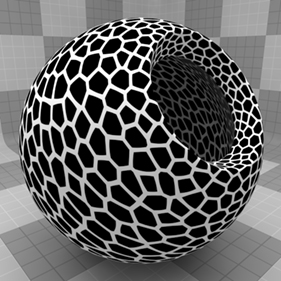
The Poisson Cells texture is one of the many procedurally generated textures provided with MODO. Procedural textures are mathematically created at render-time, and therefore have no fixed resolution, they can be magnified nearly infinitely with no visual loss in detail. The Poisson Cell pattern can be addressed by its two zones, the 'Cell' and the 'Filler'. The texture will modulate from one zone to the other based on the type and the users settings. Each zone can have a value, color and alpha value. Which of these are used is dependent on the 'Effect' to which the texture will be applied. For instance, if the texture is applied as a Displacement, the 'Value' settings would be utilized whereas setting the texture Effect to 'Diffuse Color' would use the 'Color' and 'Alpha' settings for Cell and Filler.
The Poisson Cell texture is very similar to the standard Cellular texture in many ways, but produces a more regular distribution of cells across a surface. Best results are achieved when the texture is applied to the surface with a UV map or one of the Planar projection types, allowing the texture to also seamlessly tile outside of the defined boundary. For information regarding adding and working with Shader Tree Items Layers, please reference the Shader Tree page of the documentation. When selected the following attributes appear in the Properties panel--
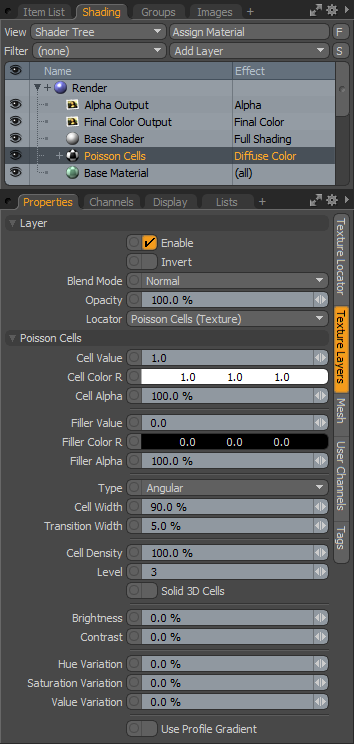 Layer--
Layer--
Enable: Toggles the effect of the layer on and off, duplicating the functionality of toggling visibility in the Shader Tree. When un-checked (disabled), the layer has no effect on the shading of the scene. However, disabled layers are saved with the scene and are persistent across MODO sessions.
Invert: Inverts the RGB values for the layer producing a negative effect.
Blend Mode: Affects blending between different layers of the same effect type, allowing user the ability to stack several layers for different effects. For more on blending, please reference the 'Blend Modes' page of the documentation.
Opacity: Changes the transparency of the current layer. Reducing this values will increasingly reveal lower layers in the shader tree if present, or dim the effect of the layer itself on the surface.
Locator: Most texture layers also have an associated 'Texture Locator' that is automatically created in the 'Item List'. This defines the mapping of the texture (way the texture is applied) to the surface. The 'Locator' option sets that association. Users can choose alternate locators, however, the need to do so will be very rare; still, there are some possible instances where users may want multiple texture items to share a single locator.
Poisson Cells--
Cell Value: Determines the magnitude of the texture where the Cell is most concentrated. This value will ramp to the Filler value. This control is only active when the texture layers Effect is set to a non-color attribute.
Cell Color: Determines the color of the texture where the Cell is most concentrated. This color will ramp to the Filler Color. The Color option is only used when the texture layer is set to an Effect that requires color.
Cell Alpha: Determines the opacity of the Cell Color value, allowing underlying Shader Tree layers to show through when the value is below 100% attenuating to fully transparent at 0%.
Filler Value: Determines the magnitude between the Cells. This value will ramp to the Filler value. This control is only active when the texture layers Effect is set to a non-color attribute.
Filler Color: Determines the color of the texture between the Cells. This color will ramp to the Filler Color. The Color option is only used when the texture layer is set to an Effect that requires color.
Filler Alpha: Determines the opacity of the 'Filler Color' value, allowing underlying Shader Tree layers to show through when the value is below 100% attenuating to fully transparent at 0%.
Type: The Type popup allows you to quickly change between the styles of Poisson Cell texture. The options are 'Round' and 'Angular'. These options determine how the texture interpolates between its sample points.
Angular-- This option creates a somewhat linear interpolation between the sample points in the texture which results in an effect similar to cobblestone in the default setting. This mode can be used to generate effects ranging from lunar surface to craggy skin.
Round-- The Round type of cellular texture creates circular spots randomly distributed based on the texture. In the default settings the texture looks simply like overlapping soft edged dots. (stretched here due to the UV map stretching around the equator) Adjusting the settings can yield effects ranging from cauliflower to chipped rock.
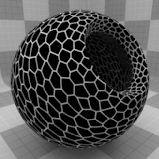 Type Angular | 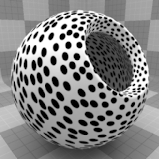 Type Round |
Cell Width: This setting determines the maximum scale of the texture features. At 100% the maximum scale of any single detail in the texture would be equal to the Texture size as set by the texture locator size values. If you want to change the scale of the details of the texture this is the value to use. To set the overall scale of the texture you will modify the texture scale on the Texture Locator tab.
 Cell Width 0% | 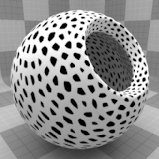 Cell Width 25% | 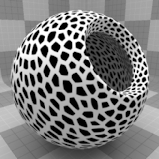 Cell Width 50% | 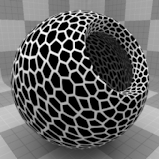 Cell Width 75% | 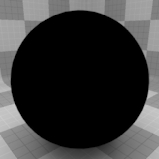 Cell Width 100% |
Filler Width: This value controls the amount of gradient falloff around each of the texture details. Driving this value over 100% can also yield interesting effects.
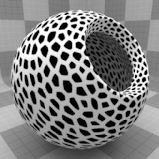 Filler Width 0% | 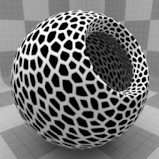 Filler Width 25% |  Filler Width 50% | 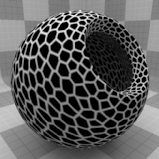 Filler Width 75% | 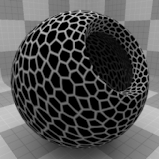 Filler Width 100% |
Cell Density: Changes the amount of coverage for each cell within the defined grid area, in essence this value is controlling the size. Outside of the grid area the Poisson Cells will tile infinitely, so adding the density will make for more cells within a single tile.
 Cell Density 0% | 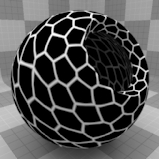 Cell Density 25% | 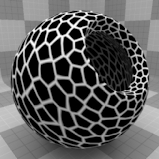 Cell Density 50% |  Cell Density 75% | 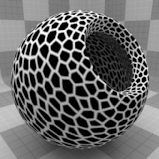 Cell Density 100% |
Level: The 'Level' option defines the number of cells in a given solution, each full level value increase doubles the number of cells from the previous level.
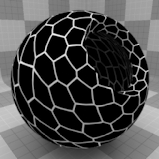 Level 1 | 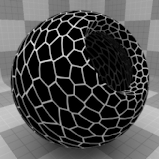 Level 2 | 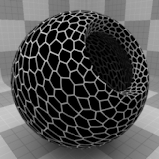 Level 3 | 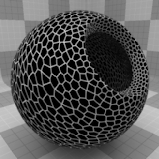 Level 4 | 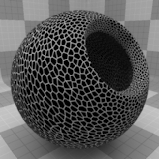 Level 5 |
Solid 3D Cells: Normally the Poisson Cells will apply to a surface with a planar type of projection, where curved glancing angle areas will stretch the texture. When applying the texture as a 3D solid where the target surface virtually carves out the texturing from a 3D volume. This is possible with the 'Solid 3D Cells' toggle, when enabled this option allows users to apply a non-planar solid projection for the target surface, but will lose on the tiling functionality and corners of some cells may intersect with the surface causing non-uniform cells, working more like the regular cellular texture.
Brightness: Increasing this value will cause the texture to favor the Cell color or value over the Filler whereas decreasing the value causes the Filler color or value to be favored.
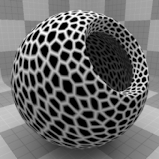 Brightness 0% | 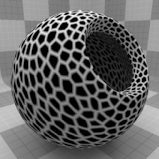 Brightness 25% | 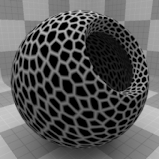 Brightness 50% | 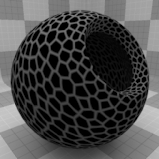 Brightness 75% | 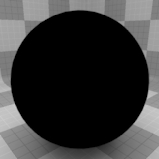 Brightness 100% |
Contrast: The Gain setting is similar to a gamma control that effects the falloff of the gradient ramp between the cell and filler values. Setting the Gain to 100% will create a very sharp falloff effect whereas setting the value to 0 would create a plateau around the value or color mid-point with sharp falloff on either extreme of the gradient.
 Contrast 0% | 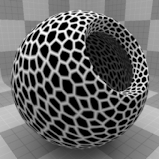 Contrast 25% | 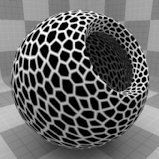 Contrast 50% | 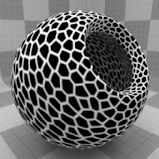 Contrast 75% | 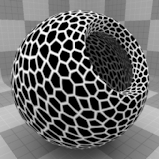 Contrast 100% |
Hue Variation: The 'Hue Variation' percentage allows you to randomly vary the hue or color of each individual cell. Higher numbers will increase the color differences between cells while lower ones will have decreased color variations.
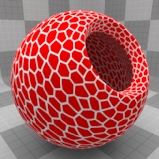 Hue 0% | 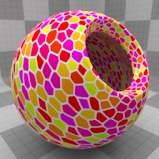 Hue 25% | 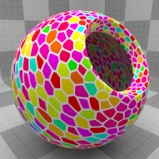 Hue 50% | 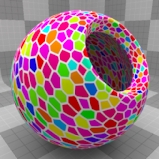 Hue 75% | 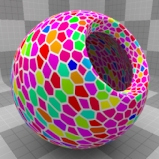 Hue 100% |
Saturation Variation: The 'Saturation Variation' percentage allows you to randomly vary the color saturation of each individual cell. Higher numbers will increase the differences between cells while lower ones will have decreased saturation variations.
 Saturation 0% | 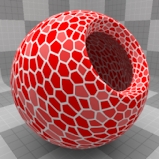 Saturation 25% | 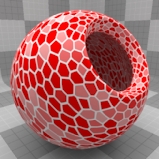 Saturation 50% | 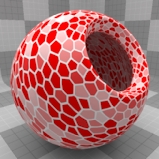 Saturation 75% | 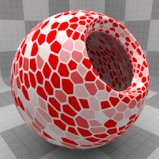 Saturation 100% |
Value Variation: The 'Value Variation' percentage allows you to randomly vary the brightness or luminosity of each individual cell. Higher numbers will increase the differences between cells while lower ones will have decreased brightness variations.
 Value 0% | 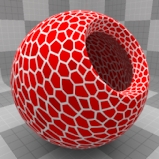 Value 25% | 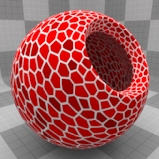 Value 50% | 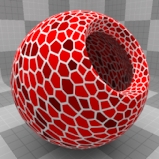 Value 75% | 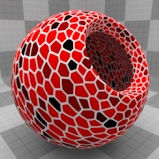 Value 100% |
Use Profile Gradient: To get extra control over the appearance of the cells, turn on Use Profile Gradient to enable the embedded gradient control. This will replace the smooth linear transition between the 'Cell' and 'Filler' values defined by the Transition Width setting with the gradient generated here. Enable the 'Use Profile Gradient' to make the embedded gradient profile visible.


